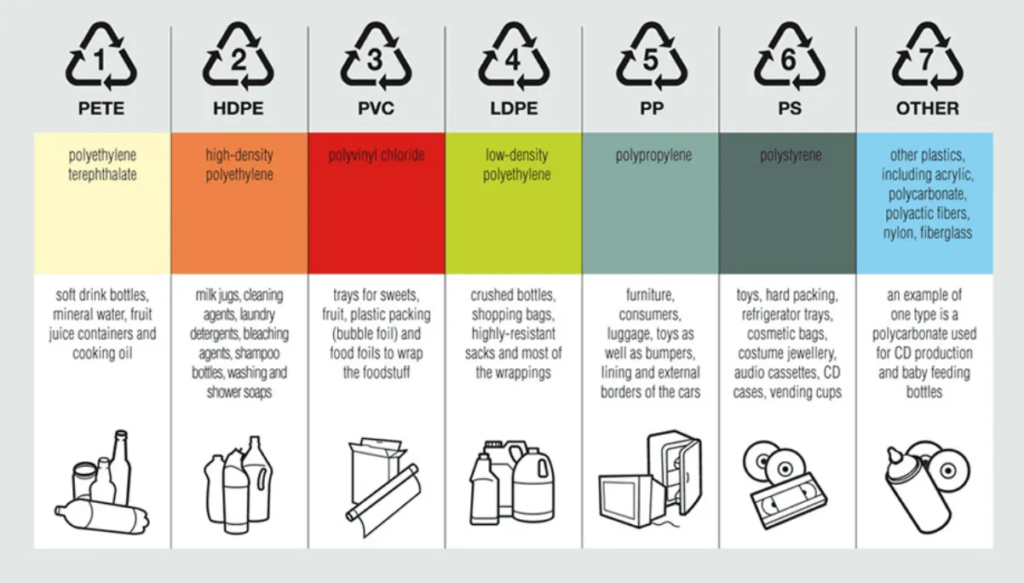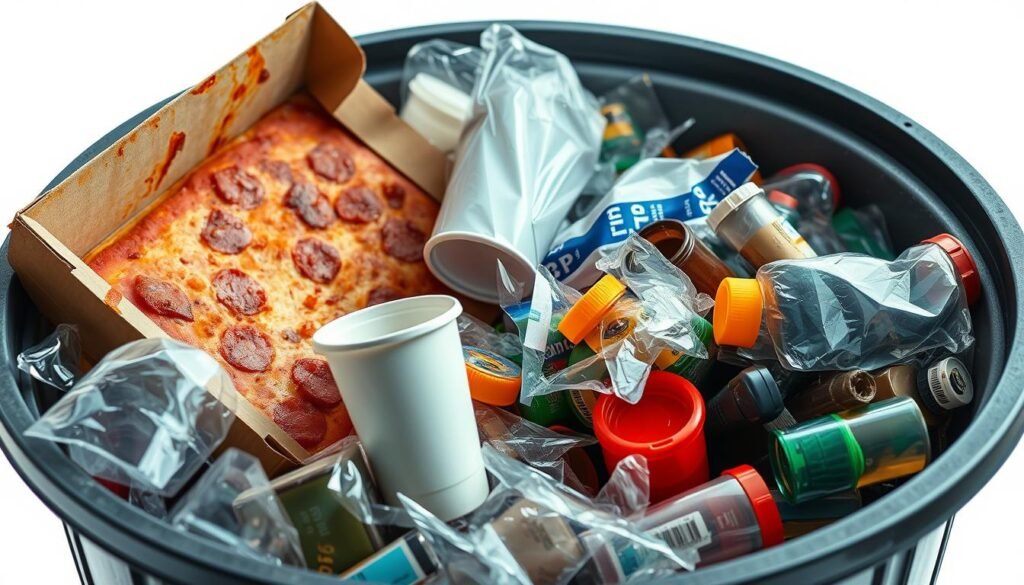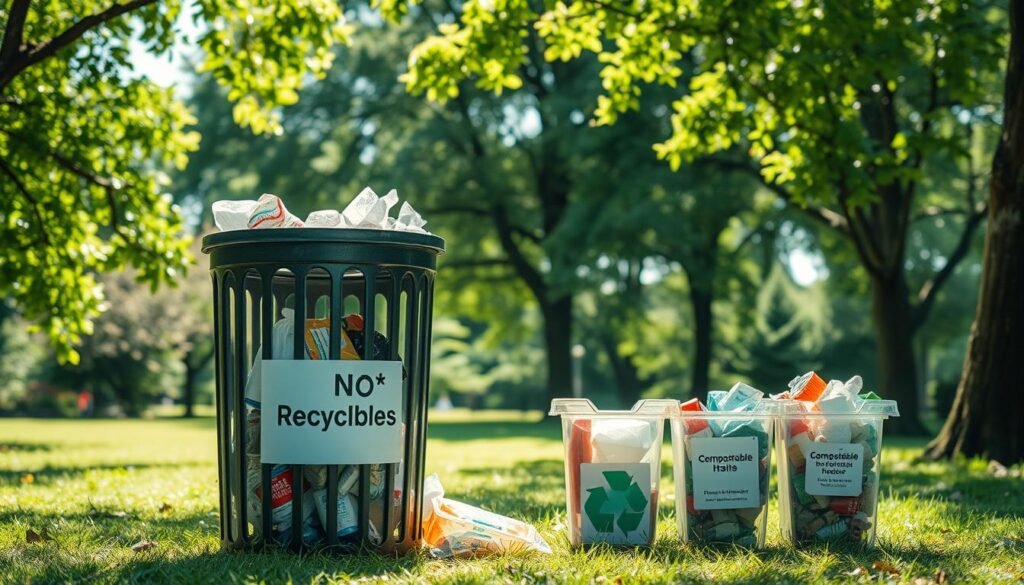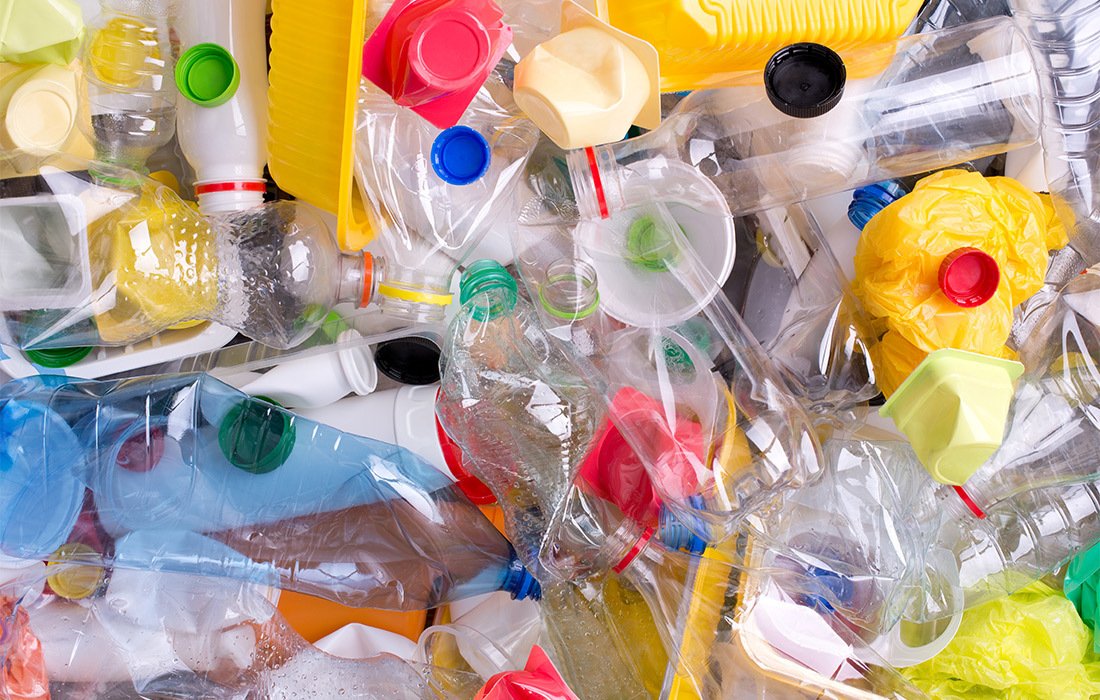Ever stood in front of your recycling bin, wondering, “Can I recycle this?” Figuring out which plastics can be recycled is tough. This is because plastic recycling guidelines are as complicated as the materials.
We aim to link your business’s recycling needs with our planet’s eco-friendly waste management. Our goal is to offer plastic recycling solutions. These solutions not only bring innovation but also build trust and help create a sustainable future.
In 2011, around 7.5 million tons of PET plastic were recycled worldwide1. However, did you know that codes #3 (PVC), #6 (PS), and #7 (other) often can’t be recycled2? Knowing these facts helps efficient recycling and reduces recycling contamination.

Key Takeaways
- Not all plastics are created equal: PET, HDPE, and PP have varying levels of recyclability.
- Understanding resin codes is crucial for proper recycling and avoiding contamination.
- Guidelines and programs vary by location—compliance ensures recycling efficacy.
- Advanced recycling machinery is vital for dealing with non-recyclable materials.
- Environmental impact is minimized when non-recyclables are disposed of correctly.
Understanding the Basics of Plastic Recycling
It’s key to grasp the plastic recycling process for a greener earth. Today we’ll talk about what makes recycling plastics essential yet challenging.

An Overview of Recyclable Plastic Shapes: Bottles, Jars, Jugs, and Tubs
Some plastic shapes like bottles and jars are easier to recycle. These include PETE and HDPE plastics. These not only recycle well but also have a ready market for the recycled materials3. It’s important to focus on these to make recycling more efficient.
The Truth About Recycling Symbols and Numbers
Recycling symbols come with numbers, but these don’t guarantee the item is recyclable. They just show the plastic type, from PETE (easily recycled) to PVC (harmful to recycle)3. Knowing these symbols and sorting carefully is key.
Sorting and Cleaning Guidelines for Plastic Recycling
Sorting is the first step in recycling plastics4. Proper sorting means plastics get recycled in the right way, using both manual and high-tech methods4. Clean plastics are crucial. Washing off dirt and glue keeps the recycling pure4. Following these steps helps recycle better and improves the end product.
- Sorting technologies help identify and separate plastics better4.
- Advanced sorting increases recycling success and minimizes waste.
- Cleaning recyclables is vital for high-quality recycling4.
| Plastic Type | Recycling Rate | Common Uses | Importance of Cleaning |
|---|---|---|---|
| PETE (1) | 20% | Beverage Bottles | High |
| HDPE (2) | Can be recycled multiple times3 | Milk Jugs, Detergent Bottles | High |
| PVC (3) | Low | Pipes, Home Products | High3 |
| LDPE (4) | Challenging to recycle when mixed3 | Squeezable Bottles, Shopping Bags | Moderate |
| PP (5) | Difficult due to shape and size3 | Yogurt Containers, Syrup Bottles | High |
| PS (6) | Difficult to recycle3 | Carry-out Containers, Egg Cartons | Moderate |
| Other | Varies | Varied Applications | Depends on Composite |
What Plastics Can Be Recycled?
Our firm tackles the complex world of plastic recycling head-on. We often discuss which plastics can be recycled at home. Let’s break down the info to help you recycle right.
Plastics marked #1 (PET) and #2 (HDPE) are the easiest for recycling programs to handle. They can be cleaned and made into new items56. But, plastics #3 (PVC), #6 (PS), and #7 (miscellaneous) are tough to recycle. They sometimes can’t be recycled because of their chemical makeup5.
Though widely used, plastic bags are usually not recyclable in curbside bins. Yet, there are new efforts to recycle them and lessen their environmental impact5. Choosing durable items over disposable ones is key to using fewer non-recyclable materials.
- Plastic bottles (PET #1) – They’re easy to recycle and can really reduce waste5.
- Milk jugs and detergent containers (HDPE #2) – These are often recyclable through curbside programs5.
- Food containers and plastic cutlery (Various codes) – Their recyclability varies, so check your local rules5.
Polypropylene (PP #5) is now often considered recyclable. This is thanks to better recycling methods6.
Some plastics are easy to recycle, while others are not. We’re focused on finding new ways to recycle more types of plastic. It’s all about reducing waste and protecting the environment6.

Recycling is crucial for dealing with plastic waste. Plastics take a long time to break down, so recycling is key. With better labels and more recycling efforts, we can improve our recycling success6.
Single-stream Recycling: Simplifying the Process
Single-stream recycling has changed how we manage waste. It makes recycling easier for everyone and improves how things operate. Different sectors love this method because it’s simpler and saves money.
The Rise of No-Sort Recycling Programs
In the US, no-sort or single-stream recycling is becoming more common. It’s easy to use because people don’t have to separate their recyclables. This leads to more people recycling. With single-stream, recycling rates could go up by 30% over older methods7. In Massachusetts, both homes and businesses are moving to this efficient method8.

Impact of Single-stream Recycling on Contamination Rates
Even though single-stream recycling is convenient and saves money, it has its problems. For example, contamination rates can reach 25% when recyclables are mixed carelessly7. This makes it important to improve sorting technology at recycling centers. Doing so could make recycled materials 90% cleaner7.
Improving Efficiency in Recycling Facilities with Modern Equipment
Modern equipment is key to better recycling facilities. With advanced sorting technology, centers can process about 35 tons of mixed recyclables hourly and more accurately7. This technology helps us use resources wisely, reduce waste, and support sustainability8.
Putting in place best practices, like accurate sorting and controlling contamination, makes recycling more efficient8. By adopting single-stream recycling and using the latest technology, we show our strong commitment to the environment and to doing things better. This approach is a big step towards greener and more efficient waste solutions.
Items Not Accepted in Standard Recycling Bins
In our push for better recycling and smart waste handling, we need to know the limits of regular bins. Not everything can go through usual recycling routes. This knowledge helps avoid pollution in the recycling process and find other ways to handle waste.
Common Non-Recyclable Plastics and Products
Many things we use every day are tough to recycle, so we need to treat them differently. Things like snack packages, rubber bands, and toothbrushes mostly can’t be recycled, with few exceptions9-k-k>. Also, while it’s possible to recycle Styrofoam cups and some takeout boxes, few places actually do it9-k-k>.

Alternatives to Disposal for Non-Recyclable Items
For stuff that doesn’t belong in the recycling, there are creative ways to avoid the trash heap. Items such as yoga mats and printer cartridges usually can’t be recycled curbside. But they can go to certain places where they’re dealt with right9-k-k>. Shoes, too, aren’t for recycling bins. But donating them gives them a second life9-k-k>. These steps help cut down landfill waste.
Understanding the Negative Impact of Contaminants in Recycling
When we mistakenly recycle the wrong items, they contaminate the batch. This makes a lot of recyclables useless. It hurts recycling efficiency and costs more in money and energy. But, by knowing which items like bubble wrap or gift cards have special recycling spots, we can help keep recycling working well. Check out these tips from the pros9-k-k>here.
| Item | Recyclable | Alternative Disposal Options |
|---|---|---|
| Yoga Mats | No | FedEx, Target, Walgreens |
| Toothbrushes | No | Limited recycling centers |
| Styrofoam containers | Yes (Limited) | Designated dropoff centers |
| Bubble Wrap | Yes | Whole Foods Market |
| Gift Cards | Yes | Whole Foods Market, Best Buy |
Following clear sorting rules and learning about responsible disposal and alternatives to recycling helps our planet. It makes our recycling efforts better and more effective.
How to Properly Dispose of Non-Recyclables
At our company, we know it’s key to properly dispose of non-recyclable waste. This helps the environment and makes recycling work better. Non-recyclables, like some plastics and electronics, can disrupt the recycling process10.They take ages to break down, leaking harmful chemicals into nature as they do.
We work with community collection centers to safely get rid of dangerous waste. This includes electronics, batteries, and bulbs. They need special care to stop them from harming the environment. Waste from items like boats adds to big pollution problems in the oceans10.
- Electronics and batteries should find their way to dedicated recycling programs designed to handle such specialized waste, safeguarding against hazardous materials entering local landfills.
- Items like plastic microbeads, which are found in products like face scrubs and toothpaste, have been specifically harmful to marine life, indicating the need for stricter waste segregation and innovative recycling technologies10.
- Not all plastics are enemies; programs exist that allow for the recycling of PETE and HDPE plastics, commonly found in containers and packaging, encouraging less waste production11.
In the UK, over 20 thousand businesses help by being “Refill Stations.” This helps a lot in reducing single-use plastics10. Also, using things like tote bags instead of plastic ones is another good step.
It’s important to avoid products made with hard-to-recycle plastics. These are usually marked with numbers three to seven. Items like coffee cup lids and yogurt containers are often not recycled11.
| Item | Alternative Disposal Method |
|---|---|
| Electronics | Local electronics recycling programs |
| Non-recyclable plastics | Community collection centers |
| Hazardous materials | Hazardous waste collection events |

Embracing responsible habits is crucial for sustainability. We’re dedicated to teaching both consumers and businesses. Together, we can practice environmentally sound methods for getting rid of non-recyclables.
Conclusion
Our look into plastic recycling shows it’s more than figuring out what can be recycled. Every year, we make 260 million metric tonnes of plastic. About two-thirds of this is thermoplastic resins, which grow by 5% every year12. The European Union sees 24.6 million tonnes of plastic waste after use12. This huge amount reminds us of our challenge. It’s crucial to include sustainable habits in our daily lives because 91% of plastic isn’t recycled. This fact stresses the need for better recycling methods13.
We aim to equip industrial leaders and experts with top-notch recycling solutions. These solutions must handle the enormous amounts of waste while being eco-friendly. Different countries in Europe use varied methods for recycling and turning waste to energy12. We’re inspired to create custom solutions for these different situations. Each step towards better recycling not only helps the Earth but keeps us safe from the dangers of plastics13.
We want to make recycling a natural part of everyone’s life. Our team works hard to improve how facilities operate and to promote careful disposal of plastics. This effort helps keep our planet cleaner. We focus on reducing the 40 kg of plastic packaging waste each UK person throws away every year12. We also tackle the problem of microplastics spreading everywhere13. With every project, we commit more to protecting our environment. Together, we can achieve the sustainable actions our world and future generations need deeply.
FAQ
What shapes of plastic are typically recyclable?
Typically, you can recycle bottles, jars, jugs, and tubs. These are often picked up in curbside programs. They are easier to recycle due to their shape and materials.
Does the recycling symbol on plastics automatically mean they can be recycled?
No, a recycling symbol and number don’t mean an item is recyclable. They just show the plastic type. Whether you can recycle it depends on your area’s rules and facility technologies.
How should plastics be sorted and cleaned before recycling?
Sort plastics by shape like your local rules say. Examples include bottles and jars. Clean them well to remove food and other residue. Make sure they are dry before you recycle.
What is single-stream or no-sort recycling, and how does it work?
In no-sort recycling, all recyclables go into one bin. Advanced machines then sort them at the facility. This process makes recycling easier for everyone.
Can single-stream recycling increase the rates of contamination?
Yes, even though it’s easier, no-sort recycling may cause more contamination. It’s key to only recycle clean, appropriate items to reduce this risk.
What are some common items that cannot be recycled in standard bins?
Items like plastic bags, foam, rubber, and pressurized tanks often can’t be recycled in standard bins. Hazardous materials are also a no-go. Always check your local rules.
How can we properly dispose of non-recyclable items?
Take them to local drop-off centers or hazardous waste programs. Some non-recyclables have special recycling options available. Do this safely and responsibly.
What steps can be taken to reduce the negative impact of contaminants in the recycling stream?
Clean and dry your recyclables well. Stick to your community’s guidelines. Learn what’s recyclable. Also, think about repurposing or donating unrecyclable items instead of throwing them away.
Why is recycling plastics important for environmental responsibility?
It cuts down the need for new materials and saves energy. It also lowers pollution and waste in landfills. Recycling helps us protect our planet for the future.
